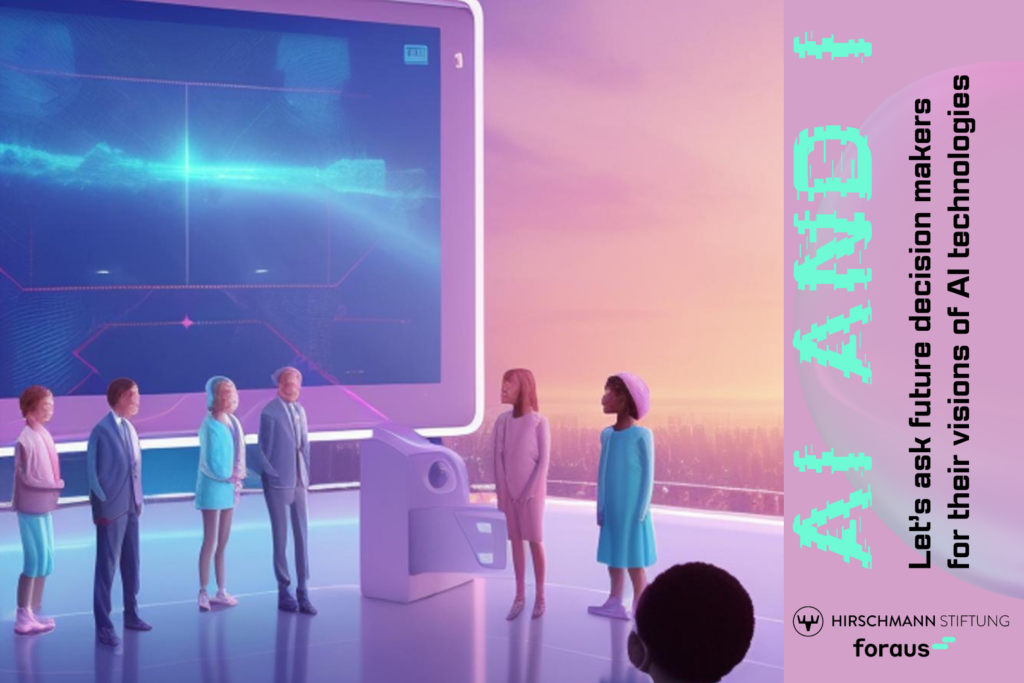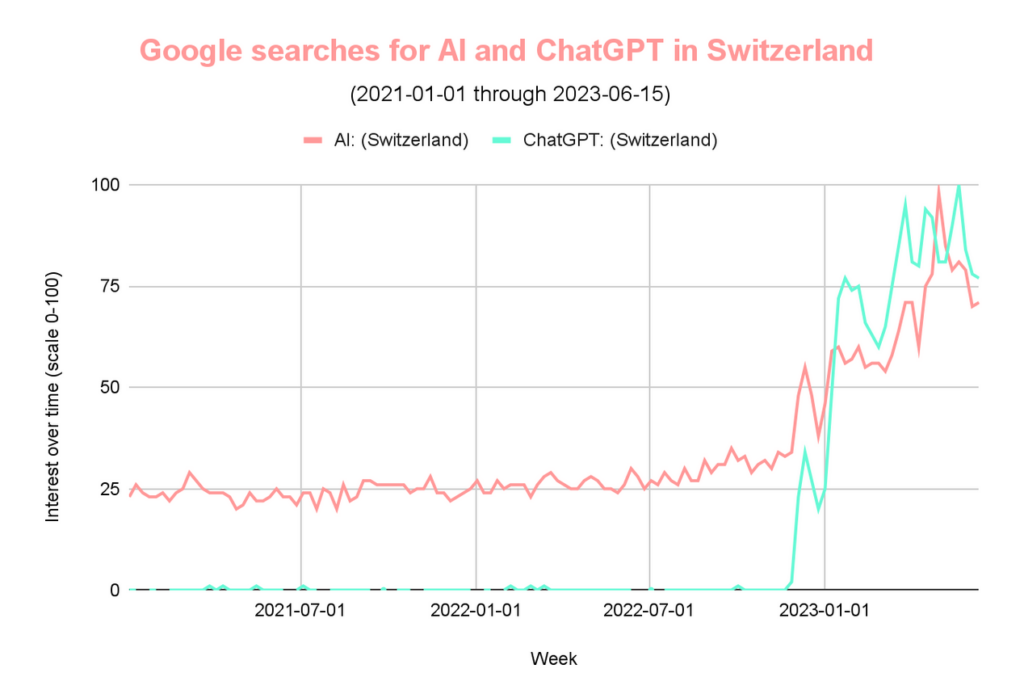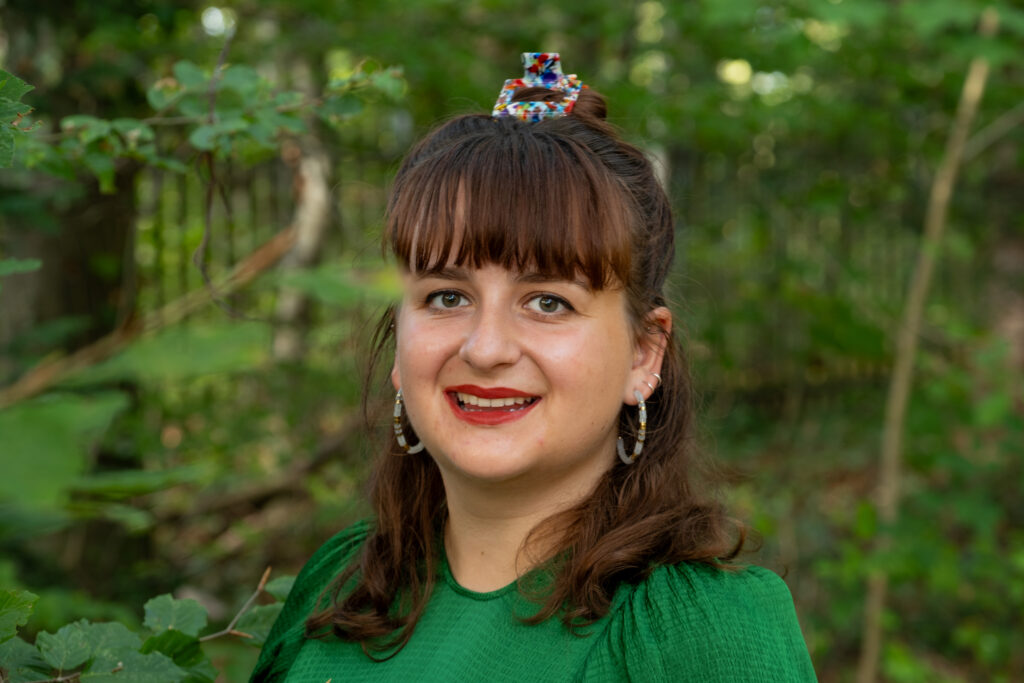Bringing together 25 young thinkers from a variety of academic fields, we used Policy Kitchen to develop visions for how artificial intelligence is likely to affect their futures. This four-part blog series on how novel tools will shape our lives and societies was rendered possible by the Hirschmann foundation.
On November 30, 2022 OpenAI launched a public interface to its Large Language Model (LLM) GPT-3 (Generative Pre-trained Transformer 3), commonly known as ChatGPT. The tool, capable of processing natural language requests from human end-users, immediately attracted public interest. ChatGPT can hold conversations, do research, write letters and articles and respond to user prompts with an eerie resemblance to human conversation. The service surpassed 100 million monthly active users by the end of January 2023, just two months after its launch. Google Trends showed an outright explosion in searches for AI, coinciding with the launch and the popularity of GPT-3.
While ChatGPT is far from the first mainstream digital tool to operate on AI technology (everyday services such as Duolingo, Trivago or LinkedIn have been relying heavily on algorithms and deep learning to customise user experiences for years already), it is the chat bot’s viral popularity, strong performance and broad range of applications that were quick to also attract decision-makers and experts from academia, economy, politics, the media and other fields.
The discussion has quickly become broader and more controversial: What are the use cases and implications of different AI technologies in different fields and contexts? What are the consequences for how we as humans interact, work and live? What are the risks of artificial intelligence and how can we handle technologies superseding human understanding? Alarmed politicians all over the world intervened with regulatory questions and started to develop new legal frameworks. Organisations such as AI4ALL, AI Ethics Lab or AI Impacts have committed themselves to researching the ethics and blind spots of AI development. From businesswomen and investors, to scholars and philosophers or legal practitioners and lobbyists – many categories of people have voiced opinions, assessment and ideas on the matter. One point of view, however, has not yet been widely explored.
Amplifying young voices on future technologies
Young people are highly affected by the sweeping technological innovation. As the younger generation forms the core of the future workforce and society, they are likely to feel the impact of AI the most, both positive and negative. But today’s youth, today’s students and young professionals are not merely at the mercy of how AI will shape their future – they should be empowered as active agents that shape, steer, engage with and contribute to making the most of new developments in the AI sector, while at the same time taking responsibility for the society they wish to live in. It is therefore crucial that young people from different walks of life, social standings and academic backgrounds are involved in decision-making and take ownership when it comes to developing holistic solutions for current and future societies.
This is exactly the approach in a joint project by foraus and the Hirschmann foundation, assisted by HSLU. In order to get a cross-disciplinary perspective on new AI applications, a cohort of 25 excelling masters students granted the Hirschmann Scholarship at Swiss Universities of Applied Sciences came together for a workshop in Berne. The goal for them as future decision-makers was to develop visions on how artificial intelligence will affect them personally as well as the social and economic communities they are part of. The workshop discussed and applied different AI tools with the participants. For instance, they got to know one another by generating an AI portrait of themselves by describing their appearance. The group moved on to compile a diverse array of possible AI applications at the hand of which they wanted to develop their visions using an adapted Designing for Wiser Action storyboard. After controversial discussions, chat bots (ChatGPT), image generating software and predictive algorithms in policing were chosen as the technologies the grant holders wanted to explore in more detail.
Digital collaboration across disciplines and countries
After the workshop, the cohort continued to collaborate on Policy Kitchen, the collaborative ideation platform co-developed by foraus. Throughout the next months, building on the lively discussions from the workshop evening, the 25 authors developed three blog posts about their visions, wishes and fears when it comes to the artificial intelligence tool of their choice.
The result is well worth the read: Three differentiated blogs capture the perspective of young people with different backgrounds, encompassing the desires, problems and goals in three application areas of AI.
The false promise of objectivity: Examining bias in predictive policing deals with the support of artificial intelligence in police work and sees the impending danger of AI-based prejudice. Revolutionising creativity: AI in graphic design recognises major upheavals for designers through image-generating AI and suggests possible solutions. The blog article Catalyst or a competitor? AI’s influence on creativity and innovation weighs up the pros and cons and stresses the importance of central guidelines.
Check out the three blogs of the 6th Hirschmann grant cohort now and form your own opinion on the future and role of AI in our society.
We thank the Hirschmann foundation for their kind support of this four-part blog series.
The cover art was created by foraus using an AI image generator.









